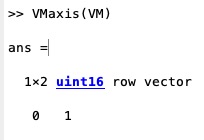VMaxis
by Tim C. Lueth, SG-Lib Toolbox: SolidGeometry 5.6 - VM/Voxels
Introduced first in SolidGeometry 4.8, Creation date: 2019-12-04, Last change: 2025-09-14
simply returns the minimal and maximal intensity values of a Voxel Model
See Also: VMcaxis
Example Illustration

Syntax
vax=VMaxis(V)
Input Parameter
Output Parameter
Examples
VMaxis(V)
Copyright 2019-2025 Tim C. Lueth. All rights reserved. The code is the property of Tim C. Lueth and may not be redistributed or modified without explicit written permission. This software may be used free of charge for academic research and teaching purposes only. Commercial use, redistribution, modification, or reverse engineering is strictly prohibited. Access to source code is restricted and granted only under specific agreements. For licensing inquiries or commercial use, please contact: Tim C. Lueth
Algorithm (Workflow)
This function, VMaxis, is designed to determine the minimum and maximum intensity values within a given voxel model. Below is a detailed explanation of the algorithm and its parameters.
Input Parameters
- V: This is the voxel model input to the function. A voxel model is a 3D array representing volumetric data, where each element corresponds to a voxel's intensity value.
Output Results
- vax: This is a two-element array containing the minimum and maximum intensity values found in the voxel model
V. The format is [min max].
Algorithm Steps
- The function begins by using the
squeeze function on V. This operation removes any singleton dimensions from the array, effectively reducing the dimensionality of V if there are any dimensions of size 1.
- Next, the function calculates the minimum intensity value in the voxel model using the
min function. It applies min three times to ensure it finds the minimum value across all dimensions of the 3D array.
- Similarly, the function calculates the maximum intensity value using the
max function, again applying it three times to cover all dimensions.
- The minimum and maximum values are then stored in the array
vax in the format [vmin vmax].
Example Usage
To use this function, simply call VMaxis(V) with your voxel model V as the argument. The function will return the minimum and maximum intensity values in the model.
Algorithm explaination created using ChatGPT on 2025-08-18 21:57. (Please note: No guarantee for the correctness of this explanation)
Last html export of this page out of FM database by TL: 2025-09-21